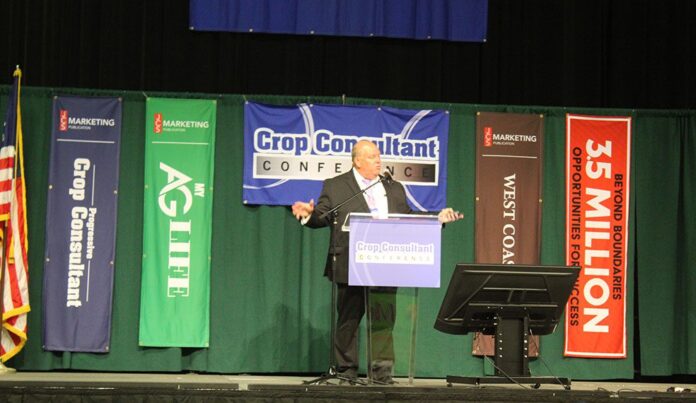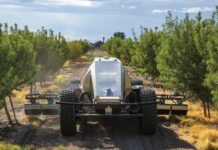
Listen to the audio version of this article. (Generated by A.I.)
As the opening speaker at the 2025 Crop Consultant Conference in September, Western Tree Nut Association’s Roger Isom caught everyone’s attention as he warned about bad precedents and unreasonable assumptions on the part of the California Department of Pesticide Regulation (DPR).
“This is a wake-up call. This is not where it ends,” Isom said as he warned of continuing efforts to restrict agricultural pesticide use.
New restrictions on the use of an important fumigant product are the latest setback for agriculture. Before this attack on the fumigant 1,3-Dichloropropene (1,3-D), chlorpyrifos was in the crosshairs of environmental justice activists, Isom said. Although no effective alternative to this pesticide was ever identified, its use was banned after the state agency’s assumption that exposure for 21 consecutive days was harmful to children.
“There is never any situation like that,” Isom countered.
In the case of 1,3-D, the state’s own study concluded there was minimal risk from ambient air exposure to the monitored pesticide during the study period. In a county known for higher use of this fumigant, the state’s own 15-week testing of air quality found no exceedances in air samples and no readings higher than 4% of the allowable amount.
In another assumption, DPR said field workers spend 14 to 28 days a year working on a field edge shared with an 80-acre 1,3-D-treated field every year for 40 years. This assumption was used to further tighten restrictions on use of this fumigant, including unrealistic buffer zones and exclusion periods.
“We are not seeing the end of the restrictions,” he said. “There are a lot of targeted products used by tree nut growers.”
The California Council for Science and Technology, an independent third party, conducted a study that found no currently available alternatives to 1,3-D and that chloropicrin would work as a universal fumigant replacement.
DPR is not hiding its intention to eliminate pesticide use, and there are plenty of environmental justice activists and anti-pesticide activists adding their voices to push in that direction, Isom said. Which is why he was so adamant about agriculture’s need to defend the use of pesticides or risk losing their use.
“We need to push for science and facts, be involved in the fight for the future of California agriculture.”
Isom noted that the current administration in California really believes in leading the nation in environmental issues, and the Legislature is already bowing to vocal groups who support them.
“If we don’t fight, we will lose valuable tools,” Isom said. “We have the right to farm. No one does it safer or protects workers like California growers. Decisions must be based on facts, not hysteria.”
It is not just fumigants that growers stand to lose, but priority pesticides are being targeted by DPR and activists. Isom said that DPR is holding workshops on their Sustainable Pest Management (SPM) plan.
Crop consultants need to be present at workshops and meetings where decisions are made and present the reality of farming without crop protection materials, Isom said.
Renee Pinel, president and CEO of Western Plant Health Association, noted SPM evolved from a work group created three years ago to help define how DPR will regulate pesticides through 2050, but with short-term objectives beginning this year.
“This process is starting to ramp up,” she warned.

Pesticide Priority Process
Pinel explained that SPM adds to UC’s integrated pest management program by incorporating environmental justice and social justice. This plan considers farms as part of a wider landscape and advocates that the decision-making process of registering a pesticide includes the entire community. The plan also adds that there must be proof that alternative, least-toxic tools were considered.
However, that wasn’t the case with chlorpyrifos, which was banned for use in agriculture before a viable alternative was offered.
This is a long-term roadmap, Pinel said of SPM, and participation in the process by a large crowd of noisy stakeholders is needed.
Attending these committee meetings won’t be pleasant, she added, because if you express a different view, there will be a negative reaction from the many environmental activists and anti-pesticide participants.
“You have to do this, you have to stand up for yourselves and the industry,” Pinel said.
Continued use of effective products and registrations of new chemistries will be more difficult with the Pesticide Priority Process, a component of SPM and a roadmap to help identify pesticides of risk. The issue, Pinel said, is that anyone can nominate a pesticide. These nominations may be driven more by emotions and may be difficult to remove from the list, she said.
The Pesticide Prioritization Process will have multiple advisory committees providing input. The process is intended by DPR to create and implement a process for prioritizing high-risk pesticides, identifying alternatives, and developing mitigation strategies and registering new products that advance SPM. Part of the DPR strategic plan is to eliminate the use of priority pesticides by transitioning to alternative products. The plan also includes bringing more alternative products to the market like biologicals and synthetic pesticides.
The process will have multiple advisory committees providing input. Those are the Pesticide Prioritization Work Group/advisory committee, the science advisory committee (an internal DPR group), Environmental Justice Committee and the SPM Advisory Committee.
The issue, Pinel said, is that no registrants are allowed on the first three of the four committees. Products likely to be nominated for prioritization, she said, have high acreage use, toxicity, persistence, or detection in food, water and environment.
These committees will need to have voices that can address the reality of how pesticides work on the ground, Pinel said. She predicted that it may take multiple alternative products to substitute for a traditional pesticide as it is transitioned out of use.
Growers and crop consultants need to show up and be visible in the room, Pinel said. This is vital because no one understands or has more expertise on how products work at the field level, what the emerging pests or diseases are, and how pests actually react to control measures than growers and consultants
Agriculture representatives being visible in the room will underscore the importance of this undertaking, she added.
“If no farmers speak up, they think what they are doing is no big deal for agriculture,” Pinel said.

Cecilia Parsons | Associate Editor
Cecilia Parsons has lived in the Central Valley community of Ducor since 1976, covering agriculture for numerous agricultural publications over the years. She has found and nurtured many wonderful and helpful contacts in the ag community, including the UCCE advisors, allowing for news coverage that focuses on the basics of food production.
She is always on the search for new ag topics that can help growers and processors in the San Joaquin Valley improve their bottom line.
In her free time, Cecilia rides her horse, Holly in ranch versatility shows and raises registered Shetland sheep which she exhibits at county and state fairs during the summer.














